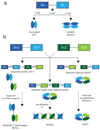Immunocytokines and bispecific antibodies: two complementary strategies for the selective activation of immune cells at the tumor site
- PMID: 26864112
- PMCID: PMC5154379
- DOI: 10.1111/imr.12391
Immunocytokines and bispecific antibodies: two complementary strategies for the selective activation of immune cells at the tumor site
Abstract
The activation of the immune system for a selective removal of tumor cells represents an attractive strategy for the treatment of metastatic malignancies, which cannot be cured by existing methodologies. In this review, we examine the design and therapeutic potential of immunocytokines and bispecific antibodies, two classes of bifunctional products which can selectively activate the immune system at the tumor site. Certain protein engineering aspects, such as the choice of the antibody format, are common to both classes of therapeutic agents and can have a profound impact on tumor homing performance in vivo of individual products. However, immunocytokines and bispecific antibodies display different mechanisms of action. Future research activities will reveal whether an additive of even synergistic benefit can be obtained from the judicious combination of these two types of biopharmaceutical agents.
Keywords: antibody engineering; armed antibodies; bispecific antibodies; immunocytokines; immunotherapy of cancer.
© 2016 John Wiley & Sons A/S. Published by John Wiley & Sons Ltd.
Figures



Similar articles
-
Bispecific antibodies for cancer therapy.Immunotherapy. 2009 Mar;1(2):211-22. doi: 10.2217/1750743X.1.2.211. Immunotherapy. 2009. PMID: 20635943 Review.
-
Bispecific antibodies and trispecific immunocytokines for targeting the immune system against cancer: preparing for the future.BioDrugs. 2013 Feb;27(1):35-53. doi: 10.1007/s40259-012-0008-z. BioDrugs. 2013. PMID: 23329400 Review.
-
[Bispecific antibodies: what future?].Med Sci (Paris). 2009 Dec;25(12):1155-8. doi: 10.1051/medsci/200925121155. Med Sci (Paris). 2009. PMID: 20035697 Review. French.
-
[Bispecific antibodies: An old story with a bright future… with CAR-T cells!].Bull Cancer. 2021 Oct;108(10S):S168-S180. doi: 10.1016/j.bulcan.2021.02.016. Bull Cancer. 2021. PMID: 34920800 Review. French.
-
Cancer therapy with bispecific antibodies: Clinical experience.Curr Opin Mol Ther. 2010 Jun;12(3):340-9. Curr Opin Mol Ther. 2010. PMID: 20521223 Free PMC article. Review.
Cited by
-
Novel antibody-cytokine fusion proteins featuring granulocyte-colony stimulating factor, interleukin-3 and interleukin-4 as payloads.J Biotechnol. 2018 Apr 10;271:29-36. doi: 10.1016/j.jbiotec.2018.02.004. Epub 2018 Feb 10. J Biotechnol. 2018. PMID: 29438784 Free PMC article.
-
Immunoglobulin Fc Heterodimer Platform Technology: From Design to Applications in Therapeutic Antibodies and Proteins.Front Immunol. 2016 Oct 6;7:394. doi: 10.3389/fimmu.2016.00394. eCollection 2016. Front Immunol. 2016. PMID: 27766096 Free PMC article. Review.
-
Tumor-directed immunotherapy can generate tumor-specific T cell responses through localized co-stimulation.Cancer Immunol Immunother. 2017 Jan;66(1):1-7. doi: 10.1007/s00262-016-1909-3. Epub 2016 Oct 6. Cancer Immunol Immunother. 2017. PMID: 27714433 Free PMC article. Review.
-
Antibody-Cytokine Fusions: Versatile Products for the Modulation of Anticancer Immunity.Cancer Immunol Res. 2019 Mar;7(3):348-354. doi: 10.1158/2326-6066.CIR-18-0622. Cancer Immunol Res. 2019. PMID: 30824549 Free PMC article. Review.
-
Evolution of the magic bullet: Single chain antibody fragments for the targeted delivery of immunomodulatory proteins.Exp Biol Med (Maywood). 2018 Jan;243(2):166-183. doi: 10.1177/1535370217748575. Epub 2017 Dec 19. Exp Biol Med (Maywood). 2018. PMID: 29256259 Free PMC article. Review.
References
-
- Krall N, Scheuermann J, Neri D. Small targeted cytotoxics: current state and promises from DNA-encoded chemical libraries. Angew Chem Int Ed Engl. 2013;52:1384–1402. - PubMed
-
- van der Veldt AA, et al. Toward prediction of efficacy of chemotherapy: a proof of concept study in lung cancer patients using [(1)(1)C]docetaxel and positron emission tomography. Clin Cancer Res. 2013;19:4163–4173. - PubMed
-
- van der Veldt AA, et al. Absolute quantification of [(11)C]docetaxel kinetics in lung cancer patients using positron emission tomography. Clin Cancer Res. 2011;17:4814–4824. - PubMed
-
- Nelson AL, Dhimolea E, Reichert JM. Development trends for human monoclonal antibody therapeutics. Nat Rev Drug Discov. 2010;9:767–774. - PubMed
-
- Walsh G. Biopharmaceutical benchmarks 2014. Nat Biotechnol. 2014;32:992–1000. - PubMed
Publication types
MeSH terms
Substances
Grants and funding
LinkOut - more resources
Full Text Sources
Other Literature Sources

